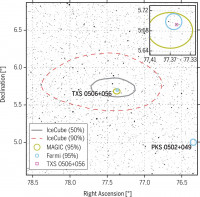High-energy neutrinos from a gamma-ray emitting supermassive black hole: the dawn of the electroweak sector of multi-messenger astronomy

Background:
Since 2010, the IceCube Observatory, utilizing a cubic-km volume of ice in Antartica, has been detecting neutrinos with energies exceeding 100 TeV (~10^13 times the energy of a visible photon), which likely originate from astrophysical sources outside of the Milky Way Galaxy. However, their sources remained unknown, mainly due to the limited accuracy of their localizations in the sky. From 2016, IceCube initiated a new, automated alert program that rapidly identifies significant neutrino candidates and widely disseminates their sky positions, so that telescopes around the world can immediately search for potential counterparts at various wavelengths.
Result:
On September 22, 2017, a neutrino with energy ~300 TeV (dubbed IceCube-170922A) was detected with relatively good sky localization, and was rapidly followed up by numerous telescopes operating across the electromagnetic spectrum. The Fermi-LAT satellite and the MAGIC telescopes identified an object (named TXS 0506+056) shining brightly in gamma-rays (Fig. 1). The object is classified as a “blazar”, a type of supermassive black hole that is actively ejecting “jets" of plasma at relativistic velocities nearly toward us. This is the first time that a likely source of high-energy neutrinos has been identified with reasonable confidence [1]. These results were published in the July 13 issue of Science magazine, in a paper authored by more than 1100 scientits in 16 collaborations, including Susumu Inoue of iTHEMS as a member of the MAGIC Collaboration [2].
Implications:
The production of such high-energy neutrinos requires the acceleration of hadrons (proton or nuclei) to extremely high energies. This implies special physical conditions in the jets from supermassive black holes, and offer valuable clues on the formation mechanism of the jets, which is not well understood. This may also be the first step in solving the long-standing mystery of the origin of ultra-high-energy cosmic rays, the highest energy particles known to exist in the Universe [3]. Finally, it may shed new light on the properties of neutrinos at energies far beyond the capability of terrestrial accelerator facilities.
Prospects:
Following on the heels of GW170817, the binary neutron star merger event discovered in August 2017 in gravitational waves and then identified in electromagnetic waves, this signals the dawn of the “electroweak" sector of multi-messenger astronomy involving neutrinos and photons. Vigorous efforts will continue in the next years, with bright prospects for elucidating the physics of supermassive black holes and their jets, the origin of high-energy neutrinos and cosmic rays, etc.
Figure 1:
Image of the sky at optical wavelengths of the region of interest. Overlayed are the positional uncertainties of the neutrino IceCube-170922A, and those of the blazar TXS 0506+056 at optical wavelengths and in gamma rays observed by Fermi and MAGIC.
References
- NSF Press Conference on Breakthrough in Multi-messenger Astrophysics
- Multimessenger observations of a flaring blazar coincident with high-energy neutrino IceCube-170922A IceCube, Fermi-LAT, MAGIC and other collaborations
- The blazar TXS 0506+056 associated with a high-energy neutrino: insights into extragalactic jets and cosmic ray acceleration MAGIC Collaboration (corresponding authors: Susumu Inoue and 4 others)
